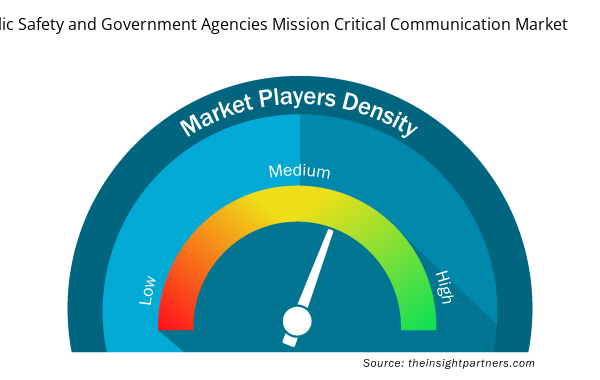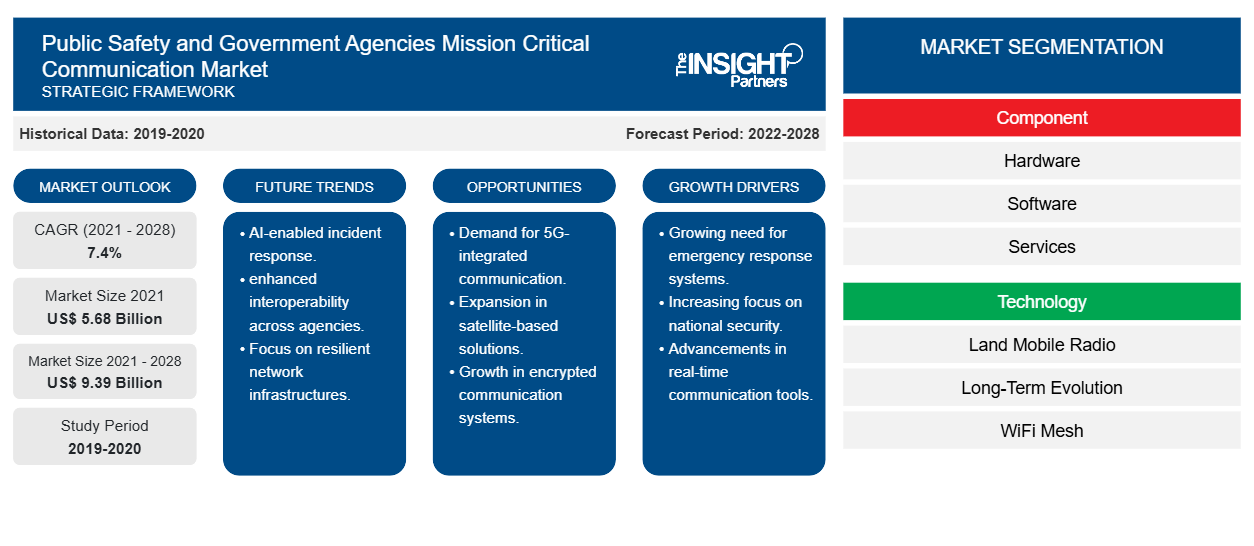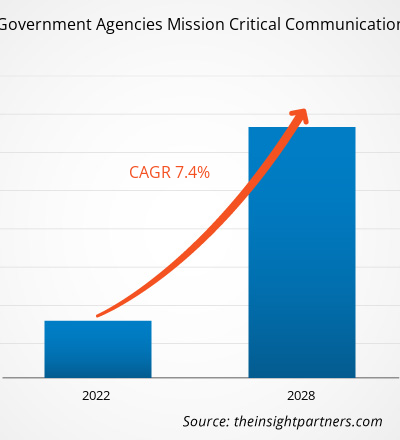公共安全および政府機関のミッションクリティカルな通信市場は、2021年に56億8,430万米ドルと評価され、2028年までに93億9,000万米ドルに達すると予測されています。また、2021年から2028年にかけて7.4%のCAGRで成長すると予想されています。
ミッションクリティカルな通信には、従来のシステムが要求を満たせない状況で、エンドユーザーへの通信方法を支援するソリューションが含まれます。また、公共安全および政府機関のミッションクリティカルな通信市場は、通信を促進し、人や財産に危険が伴う業務をサポートします。重要な通信デバイスは、重要な状況について人々を教育するために使用されます。公共安全および政府機関のミッションクリティカルな通信市場では、ネットワークオペレータは、ネットワークとサービスの急速な進化に対応して信頼性の高いネットワーク運用を保証するために、通信インフラストラクチャの新しい設計と管理戦略に重点を置いています。
COVID-19パンデミックが公共安全および政府機関のミッションクリティカル通信市場に与える影響
COVID-19 の流行は、北米の公共安全および政府機関のミッションクリティカルな通信市場に大きな影響を与え、最終用途産業に多大な経済的損失をもたらし、MCX 実装計画をさらに延期せざるを得なくなりました。この流行は、公共安全および政府機関のミッションクリティカルな通信市場のハードウェア製造現場の業務にも影響を与え、一時的な停止を余儀なくされました。その結果、いくつかの主要なコンポーネントサプライヤーとテクノロジープロバイダーがコストと生産量を削減しました。電子機器の需要は一定であったため、市場は成長を再開しました。
要件に合わせてレポートをカスタマイズする
このレポートの一部、国レベルの分析、Excelデータパックなど、あらゆるレポートを無料でカスタマイズできます。また、スタートアップや大学向けのお得なオファーや割引もご利用いただけます。
- このレポートの主要な市場動向を入手してください。この無料サンプルには、市場動向から見積もりや予測に至るまでのデータ分析が含まれます。
市場洞察
さまざまな政府機関からの需要の高まりが、公共安全および政府機関のミッションクリティカルな通信市場の成長を促進
国民は政府機関から24時間のサービスと通信を期待しています。国民は、正確で最新の情報に簡単にアクセスし、適切な政府職員とスムーズに連絡を取りたいと考えています。また、サービスが迅速かつ効果的かつ透明に提供され、問題が迅速かつ効果的かつオープンに解決されることも望んでいます。多くの政府機関は、リースされたPBXシステムやセントレックスタイプのシステムなど、時代遅れの通信インフラストラクチャにまだ依存しています。また、公共安全および政府機関のミッションクリティカルな通信市場では、政府は公共の場で尊敬されるプレーヤーになるために優れた通信システムを開発および維持しています。上記の要因により、住民のニーズと好みを評価し、複数の利害関係者の関与、情報に基づいた政策討論、緊急開発の有効性のための審議的な公共の場を促進することができます。これらの問題はすべて、公共安全および政府機関のミッションクリティカルな通信市場の需要を促進します。
コンポーネントベースの市場分析
公共安全および政府機関のミッション クリティカルな通信市場のハードウェア コンポーネントには、コマンドおよびコントロール センター、ルーターとゲートウェイ、および配布管理システムが含まれます。ハードウェア コンポーネントの展開は、公共安全機関の性質によって異なります。世界中で報告される犯罪件数の増加により、公共安全および政府機関のミッション クリティカルな通信市場の需要が高まっています。
テクノロジーに基づく市場洞察
陸上移動無線 (LMR) は双方向無線とも呼ばれ、公共安全および政府機関のミッションクリティカルな通信市場で最も広く使用されている通信技術の 1 つです。この技術は継続的にテストと改良が行われており、特に公共安全における重要な通信の成功のベンチマークと見なされています。
公共安全および政府機関のミッションクリティカルな通信市場では、製品開発は企業が製品ポートフォリオを拡大するために一般的に採用する戦略であり、顧客基盤の拡大とブランド名の維持に役立ちます。市場における最近の重要な動向のいくつかは次のとおりです。
- 2021年、インドネシア共和国政府は、イリジウム コミュニケーションズ社から調達したイリジウム プッシュツートーク (PTT) デバイス 500 台を導入し、全国の通信業務を強化しました。インドネシア政府は現在、国内の多数の島嶼地帯での移動中の通信に適した、信頼性の高い「持ち運び可能な」リアルタイム衛星通信ソリューションを手に入れています。
- 2021年、インマルサットは、インドにおける戦略的パートナーであるBSNLが、インマルサットの世界クラスのGlobal Xpress(GX)モバイルブロードバンドサービスを提供するのに必要なライセンスを取得したことを確認しました。GXは、インド電気通信省からBSNLが取得した機内および海上接続(IFMC)ライセンスに基づき、政府、航空、海洋の各分野のインドの顧客に提供されます。
公共安全および政府機関向けミッションクリティカル通信市場地域別インサイト
予測期間を通じて公共安全および政府機関のミッションクリティカルな通信市場に影響を与える地域的な傾向と要因は、Insight Partners のアナリストによって徹底的に説明されています。このセクションでは、北米、ヨーロッパ、アジア太平洋、中東およびアフリカ、南米および中米にわたる公共安全および政府機関のミッションクリティカルな通信市場のセグメントと地域についても説明します。

- 公共安全および政府機関のミッションクリティカルな通信市場の地域固有のデータを入手
公共安全および政府機関向けミッションクリティカル通信市場レポートの範囲
| レポート属性 | 詳細 |
|---|---|
| 2021年の市場規模 | 56億8千万米ドル |
| 2028年までの市場規模 | 93億9000万米ドル |
| 世界のCAGR(2021年~2028年) | 7.4% |
| 履歴データ | 2019-2020 |
| 予測期間 | 2022-2028 |
| 対象セグメント | コンポーネント別
|
| 対象地域と国 | 北米
|
| 市場リーダーと主要企業プロフィール |
|
公共安全機関および政府機関のミッションクリティカルな通信市場のプレーヤーの密度: ビジネスダイナミクスへの影響を理解する
公共安全および政府機関のミッションクリティカルな通信市場は、消費者の嗜好の変化、技術の進歩、製品の利点に対する認識の高まりなどの要因により、エンドユーザーの需要が高まり、急速に成長しています。需要が高まるにつれて、企業は提供を拡大し、消費者のニーズを満たすために革新し、新たなトレンドを活用し、市場の成長をさらに促進しています。
市場プレーヤー密度とは、特定の市場または業界内で活動している企業または会社の分布を指します。これは、特定の市場スペースに、その市場規模または総市場価値に対してどれだけの競合相手 (市場プレーヤー) が存在するかを示します。
公共安全および政府機関のミッションクリティカルな通信市場で事業を展開している主要企業は次のとおりです。
- アスコムホールディングAG(アスコム)
- グローバルスター
- インマルサット・グローバル・リミテッド
- イリジウムコミュニケーションズ株式会社
- 株式会社nbn
免責事項:上記の企業は、特定の順序でランク付けされていません。

- 公共安全および政府機関のミッションクリティカル通信市場の主要な主要プレーヤーの概要を入手
公共安全および政府機関のミッションクリティカルな通信市場のセグメンテーション:
コンポーネント別
- ハードウェア
- ソフトウェア
テクノロジー別
- ロングタームエボリューション(LTE)
- 陸上移動無線 (LMR)
- WiFiメッシュ
企業プロフィール
- アスコムホールディングAG(アスコム)
- グローバルスター
- インマルサット・グローバル・リミテッド
- イリジウムコミュニケーションズ株式会社
- 株式会社nbn
- SES SA
- テレサット
- スラーヤ通信会社
- AT&T 社
- スペースX
- 過去2年間の分析、基準年、CAGRによる予測(7年間)
- PEST分析とSWOT分析
- 市場規模価値/数量 - 世界、地域、国
- 業界と競争環境
- Excel データセット



Report Coverage
Revenue forecast, Company Analysis, Industry landscape, Growth factors, and Trends

Segment Covered
This text is related
to segments covered.

Regional Scope
North America, Europe, Asia Pacific, Middle East & Africa, South & Central America

Country Scope
This text is related
to country scope.
よくある質問
North America is known for placing a high value on public safety, with regional and national governments devoting large resources to the cause. For example, in 2020, the New York Police Department had a budget of $5.92 billion, the Los Angeles Police Department had a budget of $1.86 billion, the Chicago Police Department had a budget of $1.76 billion, the Philadelphia Police Department had a budget of $4.9 billion, and the Toronto Police Department had a budget of $1.22 billion.
In terms of market share, the market was dominated by the Long-Term Evolution (LTE) segment, which accounted for 49.7% of the total market share in 2020 and is expected to reach 47.8% of the market share by 2028. Long term evolution (LTE), commonly known as 4G (Fourth Generation) wireless standard, offers increased network capacity and speed for cellular communication devices. LTE offers up to 100 Mbps of download and 30 Mbps upload speed. One of the biggest advantages of using LTE in mission critical communication is data connectivity. Prior to LTE, the mission critical communication was majorly voice based with limited data usage. The introduction of LTE bought a wide range of applications, such as broadcasting or multi-casting, live streaming, and device-to-device communications in mission critical communication. LTE is capable of unify the existing mission critical networks based on disparate technologies, such as terrestrial trunked radio (TETRA), ultra high frequency (UHF), and very high frequency (VHF). Moreover, with the increasing use of connected devices such as drones and cameras by public safety agencies, the adoption of LTE for mission critical communication is expected to witness a significant growth during the forecast period.
A few key players operating in the public safety and government agencies mission critical communication (MCX) market are Ascom Holding AG (Ascom), Globalstar, Inmarsat Global Limited, Iridium Communications Inc., nbn co ltd., SES S.A., Telesat, Thuraya Telecommunications Company, AT&T Inc., and SPACEX, which are profiled in the report.
The global Public Safety and Government agencies mission critical communication (MCX) market was dominated by the hardware segment in 2020, which accounted for 49.1% of market share. The hardware segment is anticipated to continue its dominance during the forecast period as well. The mission critical communication is one of the prominent systems offering public safety agencies a dedicated communication platform. The hardware component of mission critical communication consists of command and control center, router and gateways, and distribution management system. The deployment of hardware component various and differs according to the nature of public safety agency. The growing number of criminal reporting across the world propels the demand for mission critical communications by public safety agencies worldwide, which drives the market growth for the hardware segment.
Many lives are lost as a result of natural calamities. Some losses could have been avoided if public agencies had offered timely information about the nature of the crisis and how to respond. For example, many lives could have been saved in Thailand in 2004 if PSAs had warned the people of the impending tidal wave. In addition, public warnings can be helpful in situations like terrorist attacks and other catastrophic events, such as the Fukushima Daichi nuclear power plant accident and the Tianjin port explosion. For this reason, public warnings share many characteristics of mission-critical communications. When properly hardened, commercial 3G and 4G networks can provide PSAs with performance and dependability superior to private radio networks. Government agencies can develop additional sites for increased redundancy, capacity, and coverage to raise backhaul bandwidth and improve physical security. The mobile network's resiliency and robustness will be increased due to this 'hardening,' such that in the case of a power outage or network infrastructure damage, the network can remain operational for a prolonged length of time. It is vital to guarantee that the standards for products and services that supply mission-critical communications are of the highest possible quality because there are scenarios where a service failure could have disastrous implications. Therefore, sufficient efforts are made to build resilient products. Mission-critical communications are not limited to a relatively small market, such as public safety, but rather that economies of scale are fully leveraged so that the additional development costs required to ensure the desired quality are shared across a more extensive user base.
The Public Safety and Government agencies mission critical communication (MCX) market is growing because of the global rise in terrorism, public safety, and desire for a reliable network during emergencies. However, the market's growth is hampered by high implementation costs, restricted data transit capabilities, and limited spectrum bandwidth. Government investments in mission-critical communication systems in the defense sector, on the other hand, are likely to generate attractive prospects for the industry in the coming years.
Trends and growth analysis reports related to Electronics and Semiconductor : READ MORE..
The List of Companies - Public Safety and Government Agencies Mission Critical Communication Market
- Ascom Holding AG (Ascom)
- Globalstar
- Inmarsat Global Limited
- Iridium Communications Inc.
- nbn co ltd.
- SES S.A.
- Telesat
- Thuraya Telecommunications Company
- AT&T Inc.
- SPACEX
The Insight Partners performs research in 4 major stages: Data Collection & Secondary Research, Primary Research, Data Analysis and Data Triangulation & Final Review.
- Data Collection and Secondary Research:
As a market research and consulting firm operating from a decade, we have published and advised several client across the globe. First step for any study will start with an assessment of currently available data and insights from existing reports. Further, historical and current market information is collected from Investor Presentations, Annual Reports, SEC Filings, etc., and other information related to company’s performance and market positioning are gathered from Paid Databases (Factiva, Hoovers, and Reuters) and various other publications available in public domain.
Several associations trade associates, technical forums, institutes, societies and organization are accessed to gain technical as well as market related insights through their publications such as research papers, blogs and press releases related to the studies are referred to get cues about the market. Further, white papers, journals, magazines, and other news articles published in last 3 years are scrutinized and analyzed to understand the current market trends.
- Primary Research:
The primarily interview analysis comprise of data obtained from industry participants interview and answers to survey questions gathered by in-house primary team.
For primary research, interviews are conducted with industry experts/CEOs/Marketing Managers/VPs/Subject Matter Experts from both demand and supply side to get a 360-degree view of the market. The primary team conducts several interviews based on the complexity of the markets to understand the various market trends and dynamics which makes research more credible and precise.
A typical research interview fulfils the following functions:
- Provides first-hand information on the market size, market trends, growth trends, competitive landscape, and outlook
- Validates and strengthens in-house secondary research findings
- Develops the analysis team’s expertise and market understanding
Primary research involves email interactions and telephone interviews for each market, category, segment, and sub-segment across geographies. The participants who typically take part in such a process include, but are not limited to:
- Industry participants: VPs, business development managers, market intelligence managers and national sales managers
- Outside experts: Valuation experts, research analysts and key opinion leaders specializing in the electronics and semiconductor industry.
Below is the breakup of our primary respondents by company, designation, and region:

Once we receive the confirmation from primary research sources or primary respondents, we finalize the base year market estimation and forecast the data as per the macroeconomic and microeconomic factors assessed during data collection.
- Data Analysis:
Once data is validated through both secondary as well as primary respondents, we finalize the market estimations by hypothesis formulation and factor analysis at regional and country level.
- Macro-Economic Factor Analysis:
We analyse macroeconomic indicators such the gross domestic product (GDP), increase in the demand for goods and services across industries, technological advancement, regional economic growth, governmental policies, the influence of COVID-19, PEST analysis, and other aspects. This analysis aids in setting benchmarks for various nations/regions and approximating market splits. Additionally, the general trend of the aforementioned components aid in determining the market's development possibilities.
- Country Level Data:
Various factors that are especially aligned to the country are taken into account to determine the market size for a certain area and country, including the presence of vendors, such as headquarters and offices, the country's GDP, demand patterns, and industry growth. To comprehend the market dynamics for the nation, a number of growth variables, inhibitors, application areas, and current market trends are researched. The aforementioned elements aid in determining the country's overall market's growth potential.
- Company Profile:
The “Table of Contents” is formulated by listing and analyzing more than 25 - 30 companies operating in the market ecosystem across geographies. However, we profile only 10 companies as a standard practice in our syndicate reports. These 10 companies comprise leading, emerging, and regional players. Nonetheless, our analysis is not restricted to the 10 listed companies, we also analyze other companies present in the market to develop a holistic view and understand the prevailing trends. The “Company Profiles” section in the report covers key facts, business description, products & services, financial information, SWOT analysis, and key developments. The financial information presented is extracted from the annual reports and official documents of the publicly listed companies. Upon collecting the information for the sections of respective companies, we verify them via various primary sources and then compile the data in respective company profiles. The company level information helps us in deriving the base number as well as in forecasting the market size.
- Developing Base Number:
Aggregation of sales statistics (2020-2022) and macro-economic factor, and other secondary and primary research insights are utilized to arrive at base number and related market shares for 2022. The data gaps are identified in this step and relevant market data is analyzed, collected from paid primary interviews or databases. On finalizing the base year market size, forecasts are developed on the basis of macro-economic, industry and market growth factors and company level analysis.
- Data Triangulation and Final Review:
The market findings and base year market size calculations are validated from supply as well as demand side. Demand side validations are based on macro-economic factor analysis and benchmarks for respective regions and countries. In case of supply side validations, revenues of major companies are estimated (in case not available) based on industry benchmark, approximate number of employees, product portfolio, and primary interviews revenues are gathered. Further revenue from target product/service segment is assessed to avoid overshooting of market statistics. In case of heavy deviations between supply and demand side values, all thes steps are repeated to achieve synchronization.
We follow an iterative model, wherein we share our research findings with Subject Matter Experts (SME’s) and Key Opinion Leaders (KOLs) until consensus view of the market is not formulated – this model negates any drastic deviation in the opinions of experts. Only validated and universally acceptable research findings are quoted in our reports.
We have important check points that we use to validate our research findings – which we call – data triangulation, where we validate the information, we generate from secondary sources with primary interviews and then we re-validate with our internal data bases and Subject matter experts. This comprehensive model enables us to deliver high quality, reliable data in shortest possible time.


 このレポートの無料サンプルを入手する
このレポートの無料サンプルを入手する